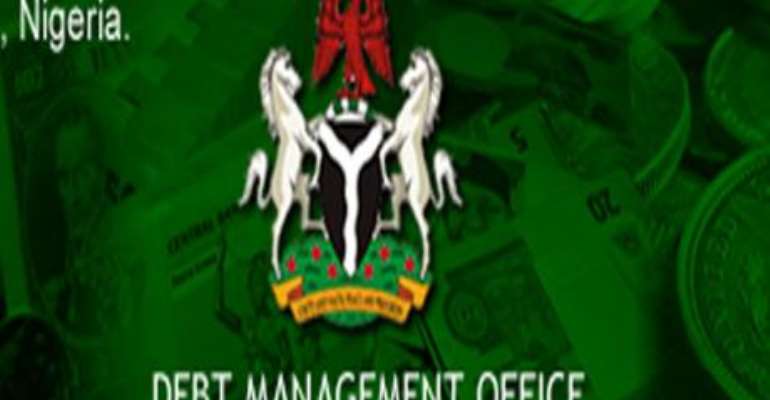DMO SETS N340BN AS DOMESTIC BORROWING LIMIT IN 2013

In the bid to curtail the federal and state governments' high propensity to borrow, the Debt Management Office (DMO) has set a limit of N340.73 billion on domestic borrowing for both tiers of government in 2013. The Office also set a $4.35 billion limit on external borrowing in the current year.
Regardless of this limit, the federal government has already planned a $1.0 billion Eurobond in 2013.
This is as the external and securitised domestic debt stock of the federal and state governments hit a total of N7.55 trillion at the end of 2012, representing an increase of marginal rise of about two per cent over the N7.47trillion recorded at the end of 2011.
The limit is in line with restrictive country-specific of 25 per cent debt-to-GDP benchmark adopted by the Federal Executive Council (FEC) in 2010 to avoid a relapse into the experiences pre-dating the debt relief of 2005 and 2006, the DMO stated in its 2012 Debt Sustainability Analysis (DSA) made available to LEADERSHIP.
The N340.74 billion domestic debt limit however falls far below the deficit of N887 billion contained in the 2013 budget, which makes analysts believe it would be very difficult if not impossible for government to adhere to the limit.
The federal government alone borrowed a total of N914bn from domestic sources in 2012.
According to the DMO, the 2013 borrowing limit is derived from the 25 per cent debt-to- GDP ratio despite that it has been revised 30 per cent in view of recent realities.
Giving rationale for its limit, the DMO said that Debt-to-GDP ratio was projected at 20.2 per cent by end-2012.
'When compared with the 25 per cent limit, the sustainable additional borrowing space for 2013 and 2014 is estimated at 4.8 per cent of GDP. The proportionate additional borrowing space in 2013 is, therefore, 2.4 per cent of GDP, bringing the expected total Debt Stock-to-GDP ratio to about 22.6 per cent by end-2013.'
Although Nigeria's debt to GDP is not yet at the 30 per cent threshold set by the government, two alarming trends are beginning to develop. The first is the rate at which the debt level is currently rising, and the second is the rising cost of government's borrowing.
While Nigeria is still a fair distance from reaching the 30 per cent threshold, analysts have warned that it was important for policy-makers to recognise these trends and learn from the country's past mistakes and those of European countries.
Reacting to the debt position, the Managing Director, Financial Derivatives Company Limited, Mr. Bismark Rewane, said there was a key difference in Nigeria's debt and those of other advanced economies.
'Instead of using debt for investment in government capital expenditure projects or fundamental transformation of essential services, the majority of Nigeria's debt has been used to plug holes in its budget, while the rest has been spent on recurrent expenditure,' he said.
Rewane said the nation's increasing debt-to-GDP ratio had not been matched by investments in infrastructure projects or by increased spending on healthcare and education.
'If the government deficit is spent on infrastructure, basic research, public health and/or education, it can increase its potential output in the long run. There are also issues surrounding the crowding out effect of the private sector,' he added.
The Debt Sustainability Analysis 2012 also recommends a major shift to more external sources of funding, which would include issuance of a Eurobond and Diaspora Bonds as well as borrowing from the commercial windows of the multilaterals.
The proposed shift away from domestic to more external borrowing is expected to help to slow down the rising trend in domestic debt outstanding and domestic debt service, and reduce the high cost of servicing the debt. Accordingly, it is expected that additional debt be raised in the ratio of 0.4 and 0.6 domestic and external sources, respectively, the report stated.
Statistics posted on the DMO website on Wednesday showed that as of December 31, 2012, the Federal Government's domestic indebtedness stood at N6.54 trillion, which was N914.69 billion higher than the level as of December 31, 2011, when it stood at N5.62 trillion.
The latest statistics on domestic debts showed that the FGN Bonds accounted for N4.08tn or 62.41 per cent of government's total domestic debts.
Nigeria Treasury Bills accounted for N2.12 trillion or 32.47 per cent of the total domestic debt, while Nigeria Treasury Bonds accounted for N334.56bn or 5.12 per cent of the debts.
On the other hand, the nation's external debt grew by $860.49 million within the same period. As of December 31, 2012, the external debt stock stood at $6.53bn as against $5.67 billion recorded as of December 31, 2011.
Further analyses of the external debt profile showed that the Federal Government had the biggest chunk of the total external debts as it had borrowed $4.14 billion as of December 31, 2012.
The 36 states of the federation, on the other hand, accounted for $2.38 billion of the nation's external debt profile. This means that the states' share of the external debt stock was 36.53 per cent.
Among the states, Lagos, Kaduna, Cross Rivers and Ogun emerged tops in terms of their contributions to the external debt stock.
Borno, Delta, Plateau and Taraba are the least indebted states as far as external debt is concerned.
The Lagos State external debt stock as at December 31, 2012 stood at $611.25m, while Kaduna's stood at $215.68m. Cross Rivers owed $113.03m and Ogun $102.06m.
On the other hand, Borno owed $14.15m; Delta, $18.99m; Plateau, $21.93m; and Taraba, $23.03m.
The National Assembly had recently approved external debt borrowings for some states that will change their debt profiles when the draw down begins.
